The capture of Tarakan Island, January 1942
The marshy island of Tarakan lies on the east coast of Borneo, near the city of Tanjungselor. The island was important since the Dutch discovered oil and dotted it with oil field pumps and tower rigs.
 The map of the Dutch East Indies 1941-1942
The map of the Dutch East Indies 1941-1942The map is courtesy of Graham Donaldson
On 25 December 1941 the first air attack on Tarakan Island is made by 4 engined flying boat. On 28 December 1941 occured a dog fight over Tarakan Island between 5 Dutch Brewster Buffalo fighters and 8 Japanese Zero fighters. Two or three Buffalo's and (possibly) two Zeros are shot down. One Dutch pilot is reported dead and one missing. The air attack on the airfield caused one plane loss and little damage.
On 9 January 1942 minelayer Prins van Oranje (Lt.Cdr. A.C. van Versendaal) is slightly damaged by Japanese air attack. Possibly 1 Japanese plane shot down.
On 10 January a Dutch Dornier Do-24K flying boat spotted a Japanese invasion fleet. The Dutch Commander ordered the destruction of all oil fields on the island. Dutch submarine K-X (Lt.Cdr. P.G. de Back) escaped although attacked by a Japanese floatplane while she was sailing through a Dutch minefield. On the same day minelayer Prins van Oranje layed the last part of the minefield. The lightship of Tarakan is bombed and damaged. Japanese destroyers came to pick the crew up.
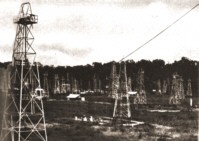 |
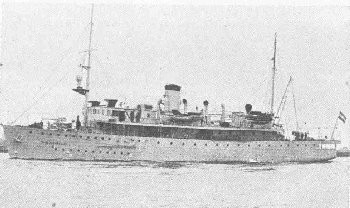 |
The main objective of the invasion of Tarakan Island was the capture of the oilfields, oil refineries and the airfield located on the island. Under the operational plan, landings were to be made on the eastern shore where the Dutch troop concentration was not particularly strong. Considering that the west coast of Tarakan Island is more suitable for amphibious landings, the Dutch command expected the invasion would be conducted there, so when the amphibious landings were later successfully delivered on the east coast all were a little bit surprised. It was also planned that after the occupation, naval units were to relieve the Army units in the defence of the island.
After mopup operations around the city of Davao, Phillipines, the Sakaguchi Detachment was to leave the securing of the city to the Miura Detachment and concentrate its strength in the vicinity of Talomo, Mintol and Daliao in preparation for the invasion of Borneo.
Tarakan Island, January 1942 |
At sunset on 10 January 1942, the convoy reached its 1st anchorage, approximately 30 km east of Tarakan. In the afternoon, Tarakan Island was visible due the smoke caused by the Dutch destruction of the oilfields and other vital installations. By night the flames were so bright that the island was clearly visible in the dark. At 8400 hours on 10 January, the Wing and Left Wing Unit boarded landing craft and started for their landing points. Initially, the Right Wing Unit, mistaking the flames from the Goonoong Tjankool oilfields for those of the Tarakan oilfield, missed its proposed landing point. The Japanese commanders realized their mistake, when the landing boats were already returning back to their ships. The first Japanese troops (Right Wing Unit) hit the shores on the east coast of Tarakan Island exactly at midnight of 11 January, followed by 2nd Kure Special Naval Landing Force thirty minutes later. After reaching a point start ca. 4 km north of the mouth of the Amal River, it recognized the position and proceeded south to the mouth of the river. They soon overwhelmed the small guard patrols guarding this sector. Arriving at the mouth of the river at dawn, the unit made a sudden attack against the Dutch pillbox located there and killed most of the the guards, while some KNIL Indonesian soldiers were captured.
Through interrogation of several Indonesian POWs, the general disposition of the enemy was obtained and the unit proceeded through the jungle to the area north of the Tarakan oilfield which they reached at approximately 1100 on the January 11th. As the Right Wing Unit advanced inland to the area north of the oilfield, they seized one important hill, but the Dutch machine-gun and rifle fire was so severe that any further advance was literally impossible. However, in spite of the Dutch counter-attack that night, the unit launched night raids. They managed to get through barbed wire, to destroy all machine-gun nests and killed almost all Dutch commanding officers with knives. They soon captured the first and second row of barracks. At daybreak the Dutch garrison commander, Lieutenant Colonel S. de Waal, discovered that his front line is weak and that all further resistance would be useless. He dispatched a messenger, under a flag of truce, with an offer to surrender. Colonel Kyohei Yamamoto, commander of the Right Wing Unit, immediately wired the commander of the Sakaguchi Detachment, informing him of the enemy's surrender. After the Dutch troops finally surrendered, the 2nd Kure Special Naval Landing Force advanced rapidly to the Tarakan airfield and occupied it by the morning of January 12th. During this advance the unit was bombed by Dutch bombers from Samarinda II airfield and 18 Japanese soldiers were killed. At 1200 hours one infantry company dispatched from the Right Wing Unit also occupied the village of Djoewata which had a Dutch coastal battery located there at the north end of the island.
During this first engagement the Japanese managed to capture a group of about 30 KNIL soldiers. When this group refused to tell them how to get to the main city of the island, they were all stabbed to death by bayonets of Japanese rifles. Only one man survived this massacre. He managed to drag himself to a hospital where he recovered.
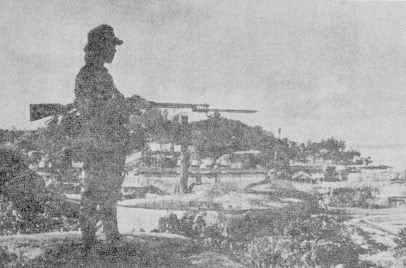 |
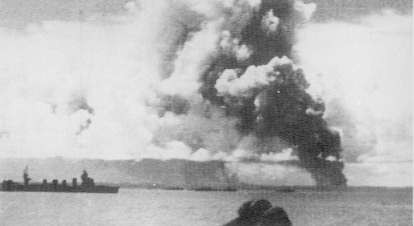 |
| The Japanese soldier on guard on Tarakan Island, 1942. The photo was taken shortly after the Japanese occupied the island. | The Japanese warships in front of Tarakan Island, January 1942. The smoke rising above the island comes from the oil fields, which were set on fire by the Dutch. |
The Left Wing Unit landed at the prearranged point at 0300 on the 11th and advanced west into the jungle toward the rear of the Dutch coastal battery which it was supposed to destroy. Due to the dense jungle and the steep terrain, the unit was able to advance only 100 meters per hour. After losing its way several times, the unit finally came out in the rear of the Dutch coastal battery around 1700 on the 12th. The Sakaguchi Detachment Headquarters had lost track of the movements of the Left Wing Unit and there had been no report from the officer who was sent out to contact the unit. Therefore, at midnight on the 11th, Lieutenant Colonel Namekata from the artillery unit was ordered to land with one infantry company with the mission of capturing the Dutch coastal battery, which was the main objective of the Left Wing Unit. At approximately 0200 on the 12th Lieutenant Colonel Namekata's unit landed at the same point as had the Left Wing unit, proceeded along the coast and by day break reached a position in front of the battery. Initially, it was planned that the Detachment Headquarters was to land in the same area as the Right Wing Unit, immediately after the area was secured and than proceed by land to the city of Tarakan. However, because the Right Wing Unit had lost its way the Headquarters could not land as scheduled. On the 12th, upon learning of the Dutch forces surrender, the Headquarters arranged with the Navy to land on Tarakan Island.
On the 12th, the following message was received by the Naval Forces: "Although the enemy has offered to surrender, it is feared that the coastal battery located at the south end of the island is not aware of this and it would be dangerous to proceed to the Tarakan pier, therefore held up your sailing". In spite of this message, the warning was ignored and the movement went on as planned. When the six minesweepers entered the bay, they were fired on by the Dutch coastal battery and two minsweepers W 13 and W 14 were hit by 4.7 inch shell and sank with most of their crew. These were the only Japanese naval losses in this action. The naval commander later promised amnesty for the guncrews and based on this promise the Dutch Island Commander managed to persuade the guncrews to surrender. The Japanese Army Commander on the other hand was brutal and had the prisoners turned over to him. He ordered the prisoners to be tied in groups of three. Some time later they were thrown into the water where all 219 Dutch soldiers drowned.
The commander of the Sakaguchi Detachment, Major-General Shizuo Sakaguchi, left his ship at about noon on the 12th and landed at the mouth of the Amal River, arriving at the office of the British Petroleum Manufacturer at sunset. On the morning of 13th, he received the enemy commander and formally accepted his surrender. Mopping-up the island was completed on the 13th. On the 14th, the entire Sakaguchi Detachment boarded the ships and left the island. Their new objective was Balikpapan.
During the night from 11 January to 12 January 1942 the minelayer Prins van Oranje tried to escape the confines of Tarakan Island but was sunk by a Japanese destroyer Yamakaze (Lt.Cdr. Shuichi Hamanaka) and patrol boat P 38 with heavy loss of life.
The casualties of the Imperial Japanese Army (Sakaguchi Detachment) numbered only 7 men killed on the land and 1 men on the water, while the naval units suffered 47 killed on the land and 200 at sea. Of those 47 killed on land, 18 were killed by the air attack on or near the airfield immediately after the surrender. The Japanese managed to capture 871 Dutch POWs.
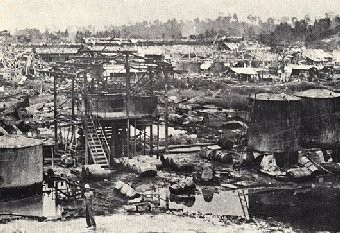
Damage after self-destruction, Tarakan Island, January 1942
Koninklijk Nederlands Indisch Leger (KNIL Army)
Dutch Garrison on the Island of Tarakan numbered approximately 1300 men. The Dutch commander on the island was KNIL Lieutenant Colonel S. de Waal.
The garrison has following units:
• Tarakan Garrison Battalion (7th KNIL Infantry Battalion), including one MG Company and a Motorised Detachment with 7 armoured cars
• Artillery Battery (4 x 75mm guns)
• Artillery Battery (4 x 75mm guns)
• Coastal Artillery Detachment (2 x 120mm guns and 4 x 75mm guns); one coastal battery with 4 x 75mm guns was placed at the north point (Cape Djoeata) of Tarakan Island while other were placed at the south point of the island.
• Anti-Aircraft Battery (4 x 40mm guns)
• Anti-Aircraft Battery (4 x 20mm guns)
• Engineer Platoon
• Mobile Auxiliary First Aid Platoon
Militaire Luchtvaart, KNIL (Air Force)
On the island were 3 Glenn-Martin bombers and a couple of Brewster Buffalo fighters - only until mid December because the field was too soft.
Zeemacht Nederlands-IndiŽ (Royal Dutch Navy)
On the island was Commandement Maritieme Middelen Tarakan under (local) Navy Commander H.C. Nieuwenhuisen.
Its Naval strengh was:
• minelayer Prins van Oranje (Lt. Cdr. A.C. van Versendaal)
• submarine K-10 (Lt.Cdr. P.G. de Back)
• patrol boat P 1 (Corporal A. de Sluys)
• Van Mastdijn/Van Masduin (exact name is unknown) = ex-Japanese fishing vessel Dornia Maru, confiscated by Dutch, displacement unknown, commander unknown, sunk south of Tarakan with troops on 10 January 1942.
• motor boat Aida = (from the Bataafsche Petroleum Mij), commander unknown
• motor boat Parsifal = commander unknown
There were several instalations on the shore that also fell under Naval Command Tarakan:
• Mine depot (dutch: Mijnenmagazin) with the capacity 310 mines and 150 tons for laying mine fields.
• Naval Air Base (Marine Luchtvaartdienst): Naval Air Group GVT-7 with 3 flying boats Dornier Do-24K
• electrical plant
• maintenance shops
• 2 underground gasoline depots of 100,000 liters each
Nihon Rikugun (Imperial Japanese Army) & Imperial Japanese Special Naval Landing Force
• Sakaguchi Brigade (56th Regimental Group) under Major-General Shizuo Sakaguchi. Brigade was concentrated at Davao, Phillipines. It was composed of the 146th Infantry Regiment and units of armoured vehicles, field artillery, military engineers and medical service. It has numbered about 5,500 men.
• Kure 2nd Special Naval Landing Force (naval infantry unit) under command of Navy Commander Masanari Siga.
This unit was also concentrated at Davao, Phillipines. It has about 1,100 men.
• Airfield Construction Group No.5
• Oilfield Construction Group No.2
Teikoku Kaigun (Imperial Japanese Navy)
The convoy for Tarakan numbered 16 transport ships carrying Sakaguchi Brigade and Kure 2nd Special Naval Landing Force. The convoy escort was under command of Rear-Admiral Shoji Nishimura in light cruiser Naka (flagship) and consisted of:
4th Destroyer Flotilla
Naka
• 2nd Destroyer Division
destroyers- Harusame, Samidare, Yudachi, Murasame
• 9th Destroyer Division
destroyers- Asagumo, Minegumo, Natsugumo
• 24th Destroyer Division
destroyers- Umikaze, Kawakaze, Yamakaze, Suzukaze
Air Group
seaplane tender Sanyo Maru
seaplane tender Sanuki Maru
one oiler
Base Force was under command of Rear-Admiral Sueto Hirose.
Base Force
• 2nd Base Force:
patrol boats- P 36, P37 and P 38
• 11th Minesweeper Division
minesweepers- W 13, W 14, W 15, W 16
• 30th Minesweeper Division
minesweepers- W 17, W 18
• 31st Submarine-chaser Division
submarine chasers- Ch 10, Ch 11, Ch 12
and other auxiliary ships.
Note The armoured cars are open-topped motor cars fitted with armoured plates ("Overvalwagens").
Note The river name is AMAL and not Amar as some sources say it is.
Forgotten Campaign: The Dutch East Indies Campaign 1941-1942
Copyright © Klemen. L. 1999-2000

